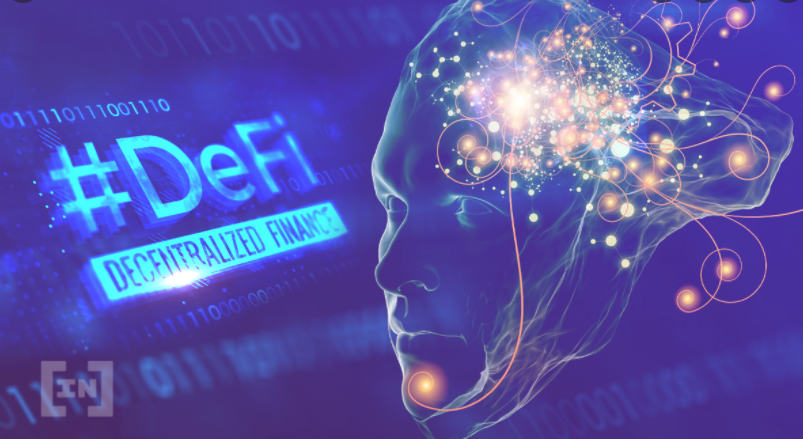
Decentralized finance, or “DeFi,” is an emerging digital financial infrastructure that theoretically eliminates the need for a central bank or government agency to approve financial transactions.
Considered many to be a catch-all term for a new wave of financial services innovation, DeFi is deeply connected to the blockchain – the distributed, decentralized and immutable public ledger on which bitcoin is built – which enables all computers (or nodes) in a network to hold a copy of the transaction history… with the idea of ensuring that no entity has control or can modify this transaction log.
Most of the financial services that could be defined as DeFi are on the Ethereum network, the second largest cryptocurrency exchange, which also acts as a platform for other blockchain applications to be built on it (the cryptocurrency of Ethereum, ether, is used to pay transaction costs). Using decentralized applications, or dApps, two or more parties can trade, lend, borrow, and trade directly using blockchain technology and smart contracts without the involvement and costs of middlemen.
Differences with Bitcoin
DeFi aims to be a fair, free and open digital market, at least in theory. In practice, at least for now, this does not always correspond to reality.
But how is DeFi different from bitcoin? While bitcoin is a decentralized digital currency that runs on its own blockchain and is used primarily as a store of value, DeFi is a concept that describes financial services built on public blockchains, such as Bitcoin and Ethereum, which for example allow users earn interest or borrow against their cryptocurrency holdings.
DeFi is made up of a variety of applications around financial services such as trading, borrowing, lending, and derivatives.
How Does DeFi Work?
DeFi uses cryptocurrencies and smart contracts to provide financial services to eliminate the need for intermediaries like guarantors. These services include lending (where users can lend their cryptocurrencies and earn interest in minutes rather than once a month), receiving a loan instantly, conducting peer-to-peer transactions without a broker, saving cryptocurrency and getting a better interest rate than from a bank, and buying derivatives like stock options and futures.
To facilitate peer-to-peer business transactions, users use dApps, most of which are on the Ethereum network. Some of the most used DeFi services and dApps include coins (Ether, Polkadot, Solana), stablecoins (whose value is linked to a currency such as the US dollar), tokens, digital wallets ( Coinbase, MetaMask), DeFi mining (also called liquidity mining), yield farming, staking, trading, borrowing, lending and saving using smart contracts.
DeFi is open source, which means protocols and applications are theoretically open for users to inspect and innovate. Therefore, users can mix and match protocols to unlock unique combinations of opportunities developing their own dApps.
What is a Smart Contract?
It is a computer code that acts as a digital agreement between two parties. A smart contract runs on a blockchain is stored in a public database, and cannot be modified. As the blockchain processes smart contracts, they can be sent automatically without the intervention of a third party. The peer-to-peer transaction is closed only when the terms of the agreement are met.
The obvious benefit of smart contracts is that they can be created so that you can borrow and lend your cryptocurrency without going through an intermediary, avoiding much of the risk associated with traditional lending.
If, for example, a borrower cannot meet their obligations under a loan, their lender can simply take back their funds, making collateral unnecessary. Additionally, DeFi savings accounts could work similarly to bank savings accounts, but offering higher interest rates or making daily, weekly, or monthly payments, depending on the platform.
Who Created DeFi?
The concept of decentralized finance was not created one person. Bitcoin is said to have been created Satoshi Nakamoto, a pseudonym for the person(s) behind the world’s first cryptocurrency and financial blockchain. The true identity, or identities behind Satoshi Nakamoto, remain unknown.
Ethereum, the bitcoin-inspired platform that a majority of DeFi services run on, was developed programmer-turned-entrepreneur Vitalik Buterin. In 2013, at the age of 19, this Russian-Canadian authored a white paper describing an alternative platform to bitcoin that would allow programmers to develop their own applications using an integrated programming language.
Thus was born Ethereum, which has grown exponentially over the past nine years. In mid-January 2022, the market capitalization of the Ethereum cryptocurrency, ether, stood at $385 billion. It is the second-largest cryptocurrency market capitalization behind bitcoin, which still reigns as the largest cryptocurrency with a market capitalization valued at $805 billion, according to CoinMarketCap.
What Can You Do with DeFi?
As mentioned above, DeFi uses cryptocurrencies and smart contracts to provide financial services without the involvement of banks. With more dApps being added, the possibilities of what you can do with DeFi continue to grow.
The most popular uses of DeFi include sending money anywhere in the world (in a short time and at an affordable price); storing money using cryptocurrency wallets (and getting higher returns than in a traditional bank); peer-to-peer borrowing and lending; trading cryptocurrencies anonymously and at any time 24 hours a day, 7 days a week; trading in tokenized versions of investments such as stocks, funds, other financial assets and non-fungible tokens (NFTs); crowd funding; and buying insurance with help from companies like Etherisc.

There is more than one way to profit from the growth of DeFi. One strategy is to generate passive income using Ethereum-based lending apps. Essentially, users lend their money and earn interest on the loans. Another strategy used is yield farming, a riskier practice for more advanced traders, in which users sift through a myriad of DeFi tokens in hopes of finding opportunities for bigger returns, but it is complicated and can lack transparency.
Read More About: What is Decentralized Finance (DeFi)?
How Risky is DeFi?
Like all other new decentralized blockchain networks trading cryptocurrencies, DeFi is very risky, especially since you are using new technology that aims to disrupt an established institution such as a centralized bank. It’s even riskier for novices drawn to the potential gains of yield farming and passive income. Ethereum has guidelines for security and scam prevention, as there are broader potential risks as well.
Fraud and crime remain a significant problem; according to calculations blockchain data platform Chainalysis, $14 billion worth of cryptocurrency was sent to illicit addresses in 2021, nearly double the figure seen in 2020.
About 2.2 billion dollars were stolen outright from DeFi protocols in 2021. The study carried out Chainalysis even figures the loot amassed the perpetrators of these thefts from the victims, of which about 2 $.8 billion of that figure comes from a scam dubbed “rug pulls.” At the end of these scams, developers create seemingly legitimate cryptocurrency projects before stealing investors’ money and disappearing.
Many attacks on DeFi exchanges in 2021 can be traced to errors in the smart contract code governing these protocols, which hackers exploit to steal funds. “The most important thing to remember is to avoid new tokens that have not been code audited. Code audits are a process where a third-party company analyzes the smart contract code behind a new token or other DeFi project and publicly confirms that the contract’s governance rules are rock-solid and contain no mechanisms. That would allow developers to run away with investors’ funds,” Chainalysis researchers note.


